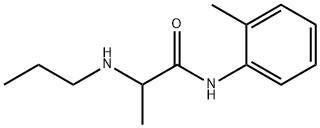
Прилокаин
- английское имяPrilocaine
- CAS №721-50-6
- CBNumberCB8270843
- ФормулаC13H20N2O
- мольный вес220.31
- EINECS211-957-0
- номер MDLMFCD00048681
- файл Mol721-50-6.mol
химическое свойство
| Температура плавления | 37-38° |
| Температура кипения | bp0.1 159-162° |
| плотность | 1.0117 (rough estimate) |
| показатель преломления | nD20 1.5298 |
| температура хранения | 2-8°C |
| растворимость | Slightly soluble in water, very soluble in acetone and in ethanol (96 per cent). |
| пка | pKa 7.32 or 7.89 (Uncertain) |
| форма | Solid |
| цвет | White to off-white |
| Растворимость в воде | 6.169g/L(25 ºC) |
| InChI | InChI=1S/C13H20N2O/c1-4-9-14-11(3)13(16)15-12-8-6-5-7-10(12)2/h5-8,11,14H,4,9H2,1-3H3,(H,15,16) |
| ИнЧИКей | MVFGUOIZUNYYSO-UHFFFAOYSA-N |
| SMILES | C(NC1=CC=CC=C1C)(=O)C(NCCC)C |
| Справочник по базе данных CAS | 721-50-6(CAS DataBase Reference) |
| Рейтинг продуктов питания EWG | 1 |
| FDA UNII | 046O35D44R |
| Словарь наркотиков NCI | Citanest |
| Код УВД | N01BB04,N01BB54 |
| Справочник по химии NIST | Propanamide, n-(2-methylphenyl)-2-(propylamino)-(721-50-6) |
| UNSPSC Code | 41116107 |
| NACRES | NA.24 |
больше
| кода HS | 2924296000 |
| Банк данных об опасных веществах | 721-50-6(Hazardous Substances Data) |
рисовальное письмо(GHS)
-
рисовальное письмо(GHS)

-
сигнальный язык
предупреждение
-
вредная бумага
H319:При попадании в глаза вызывает выраженное раздражение.
H302:Вредно при проглатывании.
-
оператор предупредительных мер
P301+P312+P330:ПРИ ПРОГЛАТЫВАНИИ: Обратиться за медицинской помощью при плохом самочувствии. Прополоскать рот.
P305+P351+P338:ПРИ ПОПАДАНИИ В ГЛАЗА: Осторожно промыть глаза водой в течение нескольких минут. Снять контактные линзы, если Вы ими пользуетесь и если это легко сделать. Продолжить промывание глаз.
Прилокаин химические свойства, назначение, производство
Химические свойства
White or almost white, crystalline powder.Использование
Prilocaine is a local anesthetic of the amino amide type. Prilocaine is often used in dentistry. Prilocaine is also often combined with lidocaine as a preparation for dermal anesthesia (lidocaine/prilocaine or EMLA), for treatment of conditions like paresthesia.Определение
ChEBI: An amino acid amide in which N-propyl-DL-alanine and 2-methylaniline have combined to form the amide bond; used as a local anaesthetic.Имя бренда
lidocaine/prilocaine topicalBrand names: Emla, LiproZonePak, Dolotranz, Livixil Pak, and Anodyne LPT.
Общее описание
Prilocaine hydrochloride is a water-soluble salt available asa solution for nerve block or infiltration in dental procedures.Prilocaine is used for intravenous regional anesthesiaas the risk of CNS toxicity is low because of the quick metabolism.Prilocaine prepared in the crystal form is used inEMLA for topical administration to decrease painful needlesticks in children. Prilocaine 4% solution should be protectedfrom light and the manufacturer recommends discardingif the solution turns pinkish or slightly darker than lightyellow. Solutions are available in various concentrations upto 4%, with or without epinephrine and with or withoutpreservatives.Фармаколо?гия
Prilocaine is less toxic than lidocaine, with a high clearance, attributable to metabolism in the lungs, kidneys and liver. It is associated with methaemoglobinaemia at doses >600mg. It is sometimes used at a concentration of 0.5% for the provision of intravenous regional anaesthesia, and a combination of prilocaine 3% with felypressin is available for low-volume local infiltration anaesthesia in dental surgery. A 2% formulation is also available for spinal anaesthesia. Prilocaine is also formulated in a eutectic mixture with lidocaine (EMLA) for topical anaesthesia.Клиническое использование
Prilocaine metabolism has beenstudied extensively in animal models, less is known aboutthe human metabolites or the human CYP enzymes involvedin their formation . The metabolism of prilocainein the liver yields o-toluidine, which is a possiblecarcinogen. Many aromatic amines, including o-toluidinehave been shown to be mutagenic, and metabolites of otoluidinehave been shown to form DNA adducts.Metabolites of o-toluidine are also believed to be responsiblefor the methemoglobinemia observed with prilocaineuse. To decrease the potential for methemoglobinemia, strictadherence to the maximum recommended dose should befollowed. Metabolism of prilocaine is extensive with lessthan 5% of a dose excreted unchanged in the urine.Прилокаин запасные части и сырье
Прилокаин поставщик
| поставщик | телефон | страна | номенклатура продукции | благоприятные условия | |
|---|---|---|---|---|---|
| 0917-3909592 13892490616 |
China | 9310 | 58 | ||
| +86-13545906766; +8613545906766 |
China | 263 | 58 | ||
| +86-17367732028 +86-17367732028 |
China | 3512 | 58 | ||
| +86-020-61855200-902 +8618124244216 |
China | 897 | 58 | ||
| +86-86-13343427080 +8613343427080 |
China | 456 | 58 | ||
| +86-86-13583358881 +8618560316533 |
China | 3094 | 58 | ||
| +86-13131129325 | China | 5887 | 58 | ||
| +8615387054039 | China | 427 | 58 | ||
| +86-18033737140 +86-17354101231 |
China | 227 | 58 | ||
| +86-53169958659 +86-13153181156 |
China | 294 | 58 |